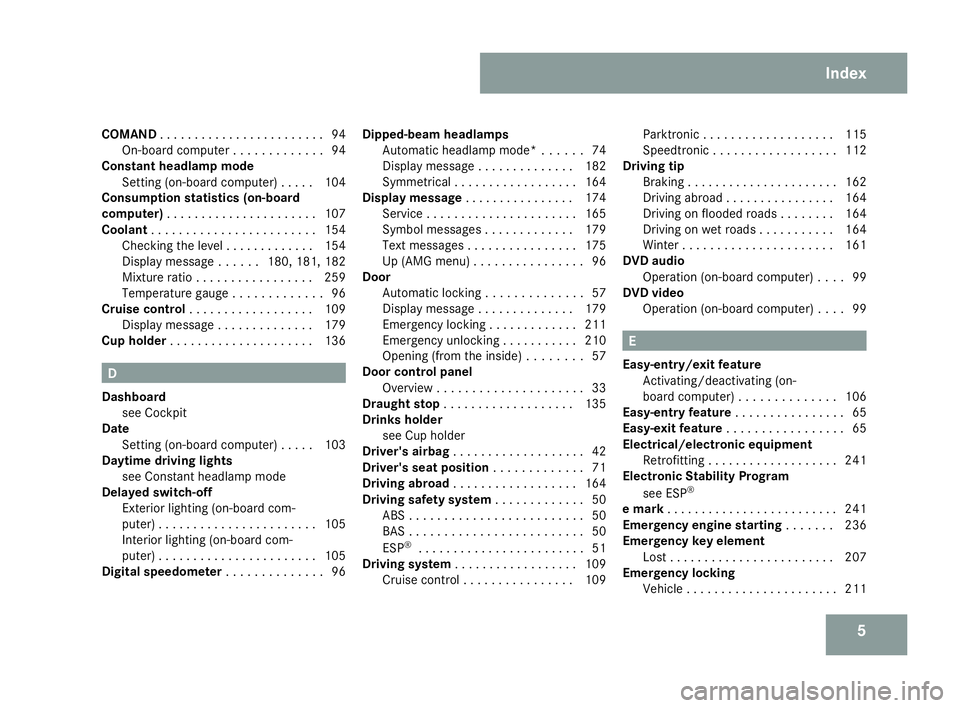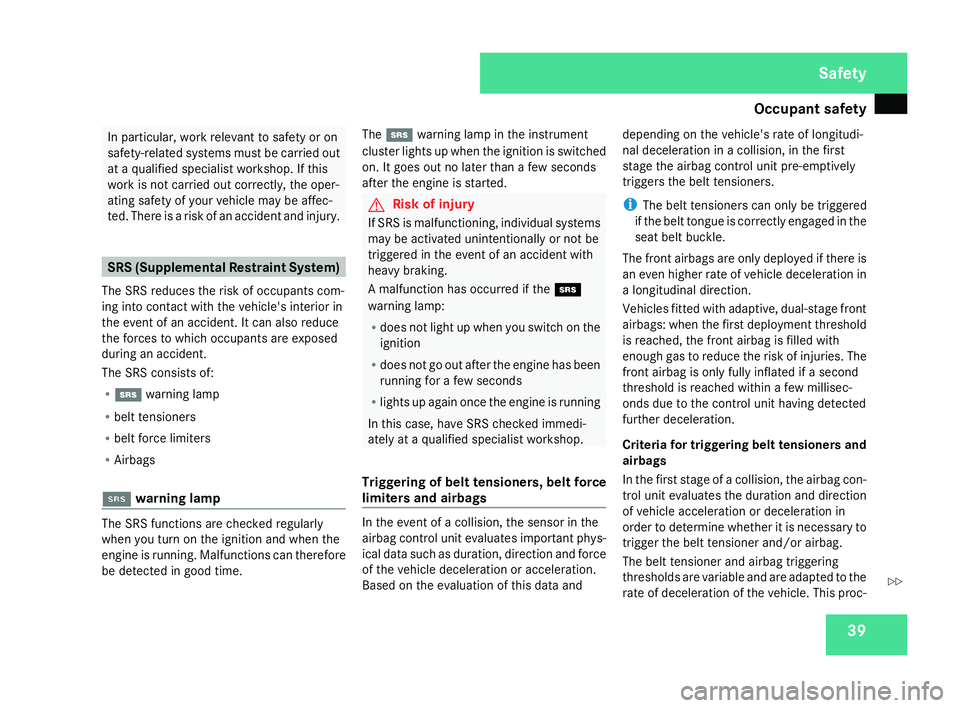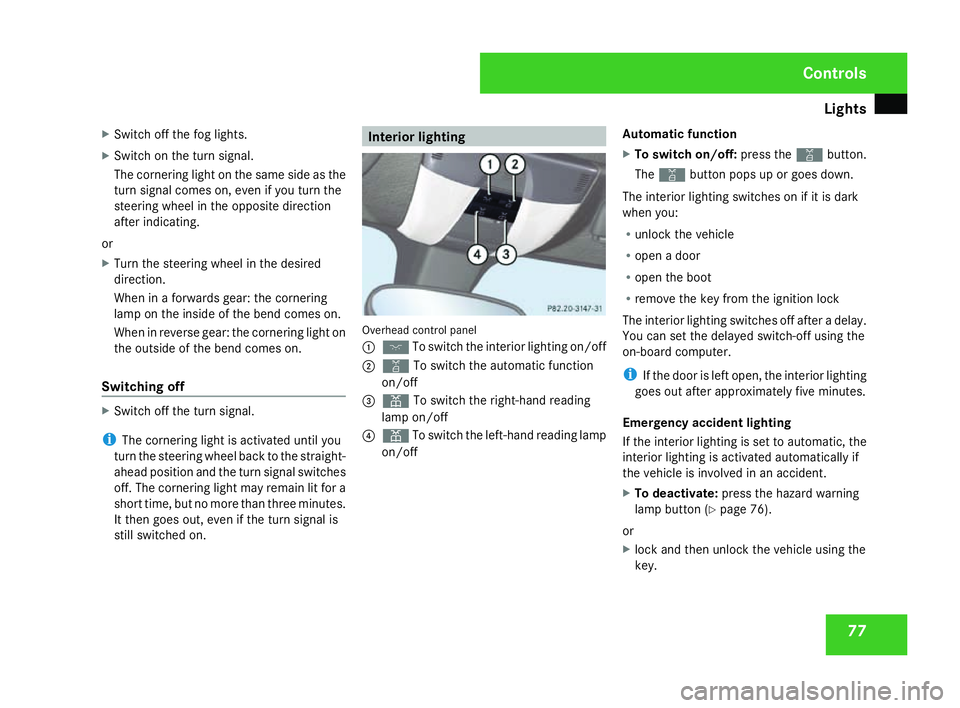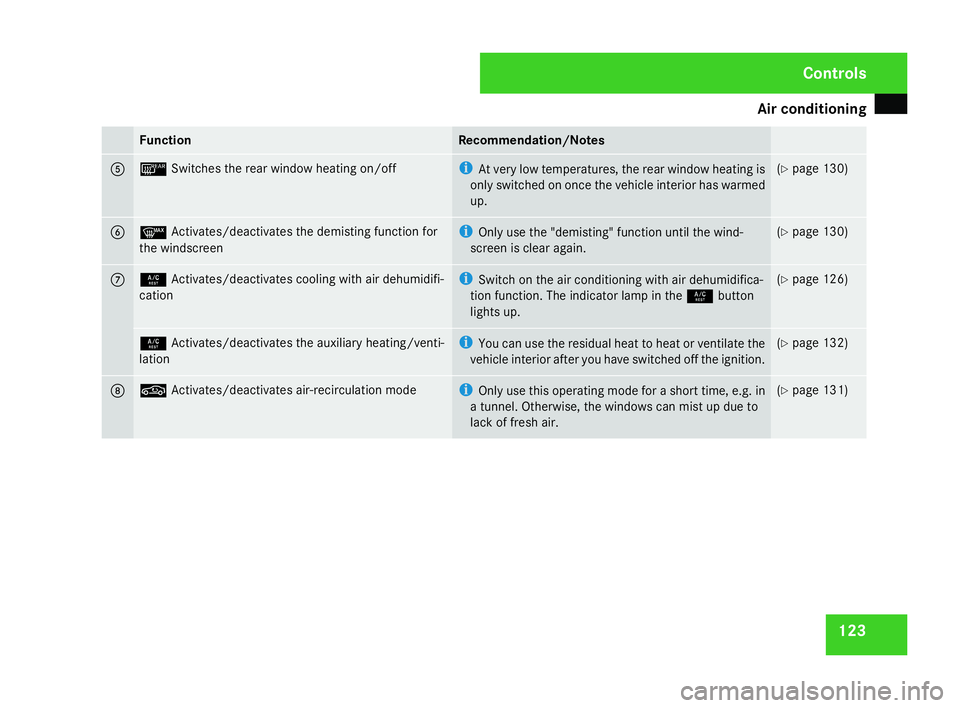interior lights MERCEDES-BENZ SLK ROADSTER 2008 Owners Manual
[x] Cancel search | Manufacturer: MERCEDES-BENZ, Model Year: 2008, Model line: SLK ROADSTER, Model: MERCEDES-BENZ SLK ROADSTER 2008Pages: 273, PDF Size: 4.42 MB
Page 8 of 273

5
COMAN
D. . . . . . . . . . . . . . . . . . . . . . . .94
On-board computer . . . . . . . . . . . . .94
Constant headlamp mod e
Setting (on-board computer) . . . . .104
Consumption statistics (on-board
computer) . . . . . . . . . . . . . . . . . . . . . .107
Coolan t. . . . . . . . . . . . . . . . . . . . . . . .154
Checking the level . . . . . . . . . . . . .154
Display message . . . . . .180, 181, 182
Mixture ratio . . . . . . . . . . . . . . . . .259
Temperature gauge . . . . . . . . . . . . .96
Cruise control . . . . . . . . . . . . . . . . . .109
Display message . . . . . . . . . . . . . .179
Cup holde r. . . . . . . . . . . . . . . . . . . . .136 D
Dashboar d
see Cockpit
Date
Setting (on-board computer) . . . . .103
Daytime driving lights
see Constant headlamp mode
Delayed switch-off
Exterior lighting (on-board com-
puter) . . . . . . . . . . . . . . . . . . . . . . .105
Interior lighting (on-board com-
puter) . . . . . . . . . . . . . . . . . . . . . . .105
Digital speedometer . . . . . . . . . . . . ..96 Dipped-beam headlamps
Automatic headlamp mode* . . . . . .74
Display message . . . . . . . . . . . . . .182
Symmetrical . . . . . . . . . . . . . . . . . .164
Display messag e. . . . . . . . . . . . . . . .174
Service . . . . . . . . . . . . . . . . . . . . . .165
Symbol messages . . . . . . . . . . . . .179
Text messages . . . . . . . . . . . . . . . .175
Up (AMG menu) . . . . . . . . . . . . . . . .96
Door
Automatic locking . . . . . . . . . . . . . .57
Display message . . . . . . . . . . . . . .179
Emergency locking . . . . . . . . . . . . .211
Emergency unlocking . . . . . . . . . . .210
Opening (from the inside) . . . . . . . .57
Door control panel
Overview . . . . . . . . . . . . . . . . . . . . .33
Draught stop . . . . . . . . . . . . . . . . . . .135
Drinks holde r
see Cup holder
Driver's airbag . . . . . . . . . . . . . . . . . . .42
Driver's seat position . . . . . . . . . . . ..71
Driving abroad . . . . . . . . . . . . . . . . . .164
Driving safety syste m. . . . . . . . . . . . .50
ABS . . . . . . . . . . . . . . . . . . . . . . . . .50
BAS . . . . . . . . . . . . . . . . . . . . . . . . .50
ESP ®
. . . . . . . . . . . . . . . . . . . . . . . .51
Driving syste m. . . . . . . . . . . . . . . . . .109
Cruise control . . . . . . . . . . . . . . . .109 Parktroni
c.. . . . . . . . . . . . . . . . . .115
Speedtronic . . . . . . . . . . . . . . . . . .112
Driving tip
Braking . . . . . . . . . . . . . . . . . . . . . .162
Driving abroad . . . . . . . . . . . . . . . .164
Driving on flooded road s.. . . . . ..164
Driving on wet road s.. . . . . . . . ..164
Winter . . . . . . . . . . . . . . . . . . . . . .161
DVD audio
Operation (on-board computer) . . . .99
DVD video
Operation (on-board computer) . . . .99 E
Easy-entry/exit feature Activating/deactivating (on -
board computer) . . . . . . . . . . . . . .106
Easy-entry feature . . . . . . . . . . . . . . ..65
Easy-exit feature . . . . . . . . . . . . . . . . .65
Electrical/electronic equipment Retrofittin g.. . . . . . . . . . . . . . . . . .241
Electronic Stability Program
see ESP ®
e mark . . . . . . . . . . . . . . . . . . . . . . . . .241
Emergency engine starting . . . . . ..236
Emergency key element Lost . . . . . . . . . . . . . . . . . . . . . . . .207
Emergency locking
Vehicle . . . . . . . . . . . . . . . . . . . . . .211 Index
171_AKB; 3; 4, en-GB
vpfaff7,
2007-11-13T10:50:25+01:00 - Seite
5
Page 42 of 273

Occupant safet
y 39In particular, work relevant to safety or on
safety-related systems must be carried out
at a qualified specialist workshop. If this
work is not carried out correctly, the oper-
ating safety of your vehicle may be affec -
ted. There is a risk of an accident and injury .SRS (Supplemental Restraint System)
The SRS reduces the risk of occupants com-
ing into contact with the vehicle's interior in
the event of an accident. It can also reduce
the forces to which occupants are exposed
during an accident.
The SRS consists of:
R 1 warning lamp
R belt tensioner s
R belt force limiters
R Airbag s
11 warning lam p The SRS functions are checked regularly
when you turn on the ignition and when the
engine is running. Malfunctions can therefore
be detected in good time. The
1 warning lamp in the instrumen t
cluster lights up when the ignition is switched
on. It goes out no later than a few seconds
after the engine is started. G
Risk of injury
If SRS is malfunctioning, individual systems
may be activated unintentionally or not be
triggered in the event of an accident with
heavy braking.
A malfunction has occurred if the 1
warning lamp:
R does not light up when you switch on the
ignition
R does not go out after the engine has been
running for a few seconds
R lights up again once the engine is running
In this case, have SRS checked immedi-
ately at a qualified specialist workshop.
Triggering of belt tensioners, belt force
limiters and airbags In the event of a collision, the sensor in the
airbag control unit evaluates important phys-
ical data such as duration, direction and force
of the vehicle deceleration or acceleration.
Based on the evaluation of this data anddepending on the vehicle's rate of longitudi-
nal deceleration in a collision, in the firs
t
stage the airbag control unit pre-emptively
triggers the belt tensioners.
i The belt tensioners can only be triggered
if the belt tongue is correctly engaged in the
seat belt buckle.
The front airbags are only deployed if there is
an even higher rate of vehicle deceleration in
a longitudinal direction .
Vehicles fitted with adaptive, dual-stage front
airbags: when the first deployment threshold
is reached, the front airbag is filled with
enough gas to reduce the risk of injuries. The
front airbag is only fully inflated if a second
threshold is reached within a few millisec-
onds due to the control unit having detected
further deceleration.
Criteria for triggering belt tensioners and
airbags
In the first stage of a collision, the airbag con-
trol unit evaluates the duration and direction
of vehicle acceleration or deceleration in
order to determine whether it is necessary to
trigger the belt tensioner and/or airbag.
The belt tensioner and airbag triggering
thresholds are variable and are adapted to the
rate of deceleration of the vehicle. This proc- Safety
171_AKB; 3; 4, en-GB
vpfaff7,
2007-11-13T10:50:25+01:00 - Seite 39 Z
Page 80 of 273

Light
s 77
X
Switch off the fog lights .
X Switch on the turn signal .
The cornering light on the same side as the
turn signal comes on, even if you turn the
steering wheel in the opposite direction
after indicating.
or
X Turn the steering wheel in the desired
direction .
When in a forwards gear: the cornering
lamp on the inside of the bend comes on.
When in reverse gear: the cornering light on
the outside of the bend comes on.
Switching off X
Switch off the turn signal .
i The cornering light is activated until you
turn the steering wheel back to the straight -
ahead position and the turn signal switches
off. The cornering light may remain lit for a
short time, but no more than three minutes.
It then goes out, even if the turn signal is
still switched on. Interior lighting
Overhead control panel
1
ð To switch the interior lighting on/of f
2 ¡ To switch the automatic function
on/of f
3 X To switch the right-hand reading
lamp on/of f
4 X To switch the left-hand reading lamp
on/of f Automatic function
X
To switch on/off: press the¡button.
The ¡ button pops up or goes down.
The interior lighting switches on if it is dark
when you:
R unlock the vehicl e
R open a door
R open the boot
R remove the key from the ignition lock
The interior lighting switches off after a delay.
You can set the delayed switch-off using the
on-board computer .
i If the door is left open, the interior lighting
goes out after approximately five minutes.
Emergency accident lighting
If the interior lighting is set to automatic, the
interior lighting is activated automatically if
the vehicle is involved in an accident.
X To deactivate: press the hazard warning
lamp button (Y page 76).
or
X lock and then unlock the vehicle using the
key. Controls
171_AKB; 3; 4, en-GB
vpfaff7,
2007-11-13T10:50:25+01:00 - Seite 77
Page 126 of 273

Air conditionin
g 123Function Recommendation/Notes
5 ¯
Switches the rear window heating on/of f i
At very low temperatures, the rear window heating is
only switched on once the vehicle interior has warme d
up. (
Y page 130 ) 6 y
Activates/deactivates the demisting function for
the windscree n i
Only use the "demisting" function until the wind-
screen is clear again. (
Y page 130 ) 7 9
Activates/deactivates cooling with air dehumidifi -
cation i
Switch on the air conditioning with air dehumidifica-
tion function. The indicator lamp in the 9button
lights up. (
Y page 126 ) 9
Activates/deactivates the auxiliary heating/venti-
latio n i
You can use the residual heat to heat or ventilate the
vehicle interior after you have switched off the ignition. (
Y page 132 ) 8 ,
Activates/deactivates air-recirculation mod e i
Only use this operating mode for a short time, e.g. in
a tunnel. Otherwise, the windows can mist up due to
lack of fresh air. (
Y page 131 ) Cont
rols
171_AKB; 3; 4, en-GB
vpfaff7,
2007-11-13T10:50:25+01:00 - Seite 123
Page 135 of 273

Opening/closing the roof
132
i
If you open the side windows manually
after closing using the convenience closing
feature, it will remain in this position when
opened using the convenience opening fea-
ture. Switching the residual heat/auxiliary
ventilation on/off
It is possible to make use of the residual heat
of the engine to continue heating the station-
ary vehicle for up to 30 minutes after the
engine has been switched off. The heating
time depends on the set interior temperature .
i The blower will run at a low speed regard-
less of the airflow setting.
i If you activate the "residual heat" function
at high temperatures, only the ventilation
will be activated. The blower runs at
medium speed. X
Make sure that the key is in position 0in
the ignition lock or that it has been
removed.
X To switch on: press theT22
/9 23
button.
The indicator lamp in the T/9 but-
ton lights up.
X To deactivate: press theT22
/9 23
button.
The indicator lamp in the T/9 but-
ton goes out.
i The auxiliary heating/ventilation is auto-
matically deactivated after about 30
minutes, or when:
R the ignition is switched on
R the battery voltage drops Opening/closing the roo
f
For safety reasons, the roof can only be
opened and closed when the vehicle is sta-
tionary. G
Risk of accident and injury
Always open or close the roof fully before
driving .
If the roof does not open or close fully, the
roof hydraulic system is depressurised and
the roof lowers itself
R after about seven minutes if the ignition
is switched on
R after about 15 seconds if the ignition is
switched off
A warning tone sounds shortly beforehand.
The message Vario-roof lowering
appears in the multi-function display.
Lock the roof again before driving on. Oth-
erwise the unlocked roof could open durin g
the journey and cause you to lose control
of your vehicle. You or other persons could
be injured as a result.
! Never sit on the rear shelf and never store
heavy objects there. You will otherwis e
22 Vehicles with Heatmatic/Thermotronic*.
23 Vehicles with Thermatic*. Controls
* optional
171_AKB; 3; 4, en-GB
vpfaff7,
2007-11-13T10:50:25+01:00 - Seite 132